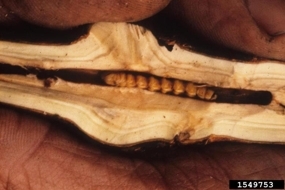Stem borers in the genus Oberea are an Eastern United States pest of blueberries, blackberries, huckleberries, azalea, rhododendron, and laurel. The ½-5/8” long adults are slender long-horned beetles with yellowish brown heads and thorax. The wing covers are yellowish gray with dark outer margins and there are 2 black spots on the thorax. The have slender antennae that are almost the length of the body.
The larvae are slender, creamy yellow, legless grubs with brown heads and mouthparts. The larval stage lives only within the stem or crown of the host plant. A distinctive patch of dark spines is present on the upper surface just behind the head.

Life Cycle
The adult beetles appear toward the end of June. After mating the females lay individual pale-yellow eggs under a flap of bark close to the base of a large diameter stem. The egg hatches in two weeks. The larvae tunnel into the cane and spend the next three years tunneling upwards at first and then downward toward the crown of plant. During the winter the activity ceases but is resumed in the spring. When their development is completed in the spring of the third year it will pupate in the tunnel and emerge in the early summer to begin the cycle again.
Symptoms and Damage
The first sign of damage by the adult beetle is messy girdling of the cane above and below where the egg has been laid. The branch tip will brown and die. Scout for the symptoms in the last two weeks of June and early July. Once the larva is active symptoms may not appear for a while although the larvae may occasionally burrow to the surface through a small round hole to push excess light yellow frass (droppings) out of the tunnel. These may remain on the canes or form piles on the ground. Infested twigs will wilt and brown and will have hollow tunnels if broken open.
Control Measures
Infested canes and wilted terminals should be removed as soon as they detected. Cut the stems well below the tunneled-out sections. Bag or burn (if allowed) the cuttings. If plants are pruned of dead or weakened canes regularly then stem borers may be removed along with them. Insecticides are not generally recommended for control.
Despite good cultural practices, pests and diseases at times may appear. Chemical control should be used only after all other methods have failed.
For pesticide information or other questions please call toll free: 877-486-6271.
UConn Home and Garden Education Center, 2017